XR/AR in Healthcare: Top 10 Use Cases in 2024
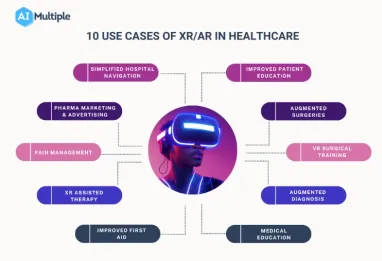
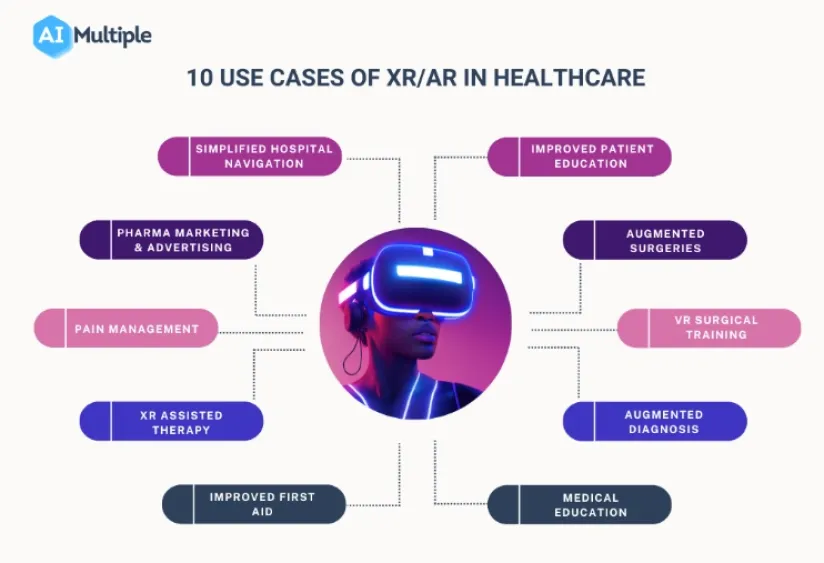
The global digital healthcare market is expected to exceed $430 billion by 2028 (see Figure 1). The COVID-19 pandemic imposed new challenges and expectations on the health sector, accelerating the already ongoing digital transformation of healthcare.
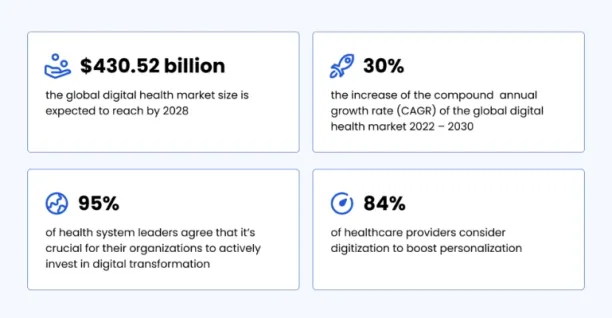
Figure 1: Trends and projections in healthcare, Source: intellectsoft
Telemedicine and telehealth services have become an integral part of healthcare solutions but companies have difficulty providing personalized, high-quality, and accessible solutions to their customers.1 As a sector inevitably tied to technological advancement, XR is expected to become prevalent in healthcare with various applications.2
We explored 10 use cases of XR technologies in healthcare in this article to help you understand how you can leverage XR in your healthcare organization.
1- Improved patient education, self-care & engagement
XR-based solutions offer tools for patients who do not have access to medical help or experience problems that do not require the physical presence of a professional. Patients can utilize XR technology to:
- explain their symptoms with the help of visual stimuli
- track their healing process
- improve physical therapy
- get directions/assistance from the nearest medical professionals
- better grasp their condition and make informed decisions
- view their medical data
2- Augmented surgeries
AR technology can serve as an assistant tool in surgical procedures, especially when used through glasses or lenses by doctors. With AR tools, doctors can impose relevant information and schematics on their vision while keeping their hands free. Practical applications include:
- Step-by-step surgical visualization
- Monitoring patient vitals in real-time
- Viewing necessary schematics such as CT or MRI data imposed on a patient’s body
- Visualization of patient-specific anatomy
- Identifying abnormal surgical encounters
- Remote assistance from other professionals
All of which help to reduce risks while improving accuracy.
3- VR surgical training
In the past, medical professionals had to rely on traditional methods such as cadavers to learn and practice surgical procedures. However, these methods can be expensive, time-consuming, and limited in their ability to accurately mimic real-life scenarios.
XR technology offers immersive and effective solutions for medical professionals to learn and practice surgical procedures. XR-based surgery simulation offers a safe and realistic opportunity for professionals to experiment, train, and collaborate.
Research by Imperial College London concludes that 83% of VR-trained participants could complete a spinal surgery with minimal guidance, whereas 0% of traditionally trained participants could accomplish the same task.3
4- Augmented diagnosis
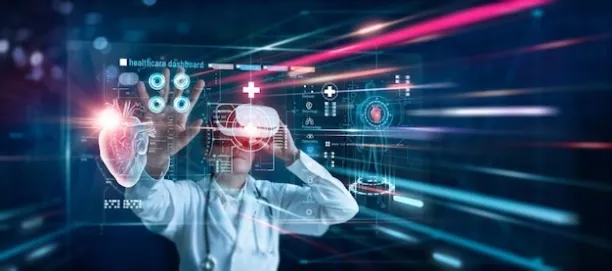
Figure 2: Doctor with AR Headset Viewing Patient Data
Patients need to properly describe their symptoms for an accurate diagnosis, which may be difficult sometimes. AR can help overcome barriers between doctors and patients by offering visual representations and scenarios regarding their conditions (see Figure 2). This results in a better understanding between the doctor and the patient.
5- Medical Education
Remote education has rapidly increased following the pandemic, but medical education relies significantly on offline and practical training. Offering a tangible solution, XR can assist medical students and healthcare workers by presenting immersive learning experiences that help to:
- simplify understanding of complex concepts
- experience human anatomy in 3D without cadavers or physical equipment
- integrate different sources & data into one platform
- observe professionals from a first-person view while they work
- translate medical education to real-life scenarios
6- Improved first aid
Augmented reality gives first aid personnel valuable tools while keeping their hands free. Beneficial applications include:
- Access to patient data records
- Remote professional assistance via AR video conferencing
- Instructions on the first aid procedure
- Diagnosis assistance
- Keeping data organized and at hand
7- XR assisted therapy
Exposure therapy has been a go-to practice in treating psychological conditions such as OCD (obsessive-compulsive disorder), PTSD (post-traumatic stress disorder), anxiety, addiction, and phobias. XR-assisted exposure therapy can improve treatment outcomes by offering:
- control over the scenario
- safety
- variation in stimuli
- repetition of scenarios in a safe environment
- self-practice
8- Pain management
VR solutions can be used to provide patients with calming environments during operations under local or no anesthesia which may help patients to experience pain less by distracting the patient’s attention away from pain while helping to block pain signals from reaching the brain.
VR therapy has also proven itself in reducing chronic pain and is authorized by the FDA as of 2021.4
9- Pharma marketing & advertising
Research suggests that 72% of Internet users searched for health-related information on search engines in 2021.5 Communicating clearly and accurately is essential when addressing customers’ needs and expectations, and AR can help pharma companies by offering a new content format for presenting drug information and mechanisms. (see Figure 3).
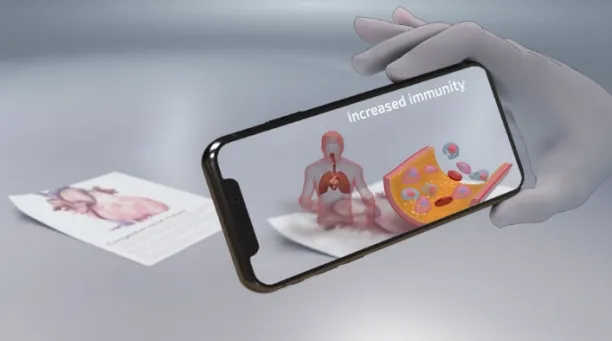
Figure 3: AR in Pharma product visualization, Source: AugRay
10- Simplified hospital navigation
Navigating medical facilities with many buildings and floors can be complex and time-consuming. AR-assisted smartphone solutions help patients reach their desired location by directing them with virtual arrows and real-time information about their surroundings.
Don’t hesitate to contact us if you plan to leverage XR in your organization:
This article was drafted by former AIMultiple industry analyst Berke Can Agagündüz.
External Links
- 1. Bestsennyy, Oleg; Gilbert, Greg; Harris, Alex; Rost, Jennifer (July 9, 2021). “Telehealth: A quarter-trillion-dollar post-COVID-19 reality?”.McKinsey. Retrieved December 2, 2022.
- 2. “Augmented and Virtual Reality in Healthcare Market“. Precedence Research. Retrieved December 8, 2022.
- 3. “Virtual Reality in Healthcare – a Study on VR Surgery”. VRDirect. October 28, 2019. Retrieved December 12, 2022.
- 4. Godman, Heidi (April 1, 2022). “Virtual reality for chronic pain relief”. Harvard Health Publishing. Retrieved December 12, 2022.
- 5. “Inspiring Ways Healthcare Marketing is Using Augmented Reality.” 10TH DEGREE. Retrieved December 2, 2022.

Cem has been the principal analyst at AIMultiple since 2017. AIMultiple informs hundreds of thousands of businesses (as per similarWeb) including 60% of Fortune 500 every month.
Cem's work has been cited by leading global publications including Business Insider, Forbes, Washington Post, global firms like Deloitte, HPE, NGOs like World Economic Forum and supranational organizations like European Commission. You can see more reputable companies and media that referenced AIMultiple.
Throughout his career, Cem served as a tech consultant, tech buyer and tech entrepreneur. He advised businesses on their enterprise software, automation, cloud, AI / ML and other technology related decisions at McKinsey & Company and Altman Solon for more than a decade. He also published a McKinsey report on digitalization.
He led technology strategy and procurement of a telco while reporting to the CEO. He has also led commercial growth of deep tech company Hypatos that reached a 7 digit annual recurring revenue and a 9 digit valuation from 0 within 2 years. Cem's work in Hypatos was covered by leading technology publications like TechCrunch and Business Insider.
Cem regularly speaks at international technology conferences. He graduated from Bogazici University as a computer engineer and holds an MBA from Columbia Business School.
To stay up-to-date on B2B tech & accelerate your enterprise:
Follow on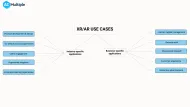
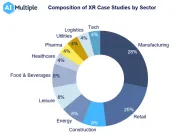
Comments
Your email address will not be published. All fields are required.